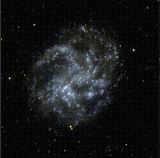
NGC 4395
Encyclopedia
NGC 4395 is a low surface brightness
spiral galaxy
with a halo that is about 8′ in diameter. It has several wide areas of greater brightness running northwest to southeast. The one furthest southeast is the brightest. Three of the patches have their own NGC numbers: 4401, 4400, and 4399 running east to west.
NGC 4395 is notable in that it contains one of the smallest supermassive black hole
ever discovered. The central black hole has a mass of "only" 300,000 sun masses. The black hole
was discovered in 1989, and had been judged to be between 55,000 and 65,000 sun masses. Recent estimates have thus quintupled the estimated size, but it is still far smaller than other black holes in its class. It is likely that is it so small because it has little material around it to add to its bulk. Indeed, stars are conspicuously absent in its immediate vicinity, and so it was "starved" down to that size or has never been able to fully grow, unlike most similar black holes.
Low surface brightness galaxy
A low surface brightness galaxy, or LSB galaxy, is a diffuse galaxy with a surface brightness that, when viewed from Earth, is at least one magnitude lower than the ambient night sky....
spiral galaxy
Spiral galaxy
A spiral galaxy is a certain kind of galaxy originally described by Edwin Hubble in his 1936 work The Realm of the Nebulae and, as such, forms part of the Hubble sequence. Spiral galaxies consist of a flat, rotating disk containing stars, gas and dust, and a central concentration of stars known as...
with a halo that is about 8′ in diameter. It has several wide areas of greater brightness running northwest to southeast. The one furthest southeast is the brightest. Three of the patches have their own NGC numbers: 4401, 4400, and 4399 running east to west.
NGC 4395 is notable in that it contains one of the smallest supermassive black hole
Supermassive black hole
A supermassive black hole is the largest type of black hole in a galaxy, in the order of hundreds of thousands to billions of solar masses. Most, and possibly all galaxies, including the Milky Way, are believed to contain supermassive black holes at their centers.Supermassive black holes have...
ever discovered. The central black hole has a mass of "only" 300,000 sun masses. The black hole
Black hole
A black hole is a region of spacetime from which nothing, not even light, can escape. The theory of general relativity predicts that a sufficiently compact mass will deform spacetime to form a black hole. Around a black hole there is a mathematically defined surface called an event horizon that...
was discovered in 1989, and had been judged to be between 55,000 and 65,000 sun masses. Recent estimates have thus quintupled the estimated size, but it is still far smaller than other black holes in its class. It is likely that is it so small because it has little material around it to add to its bulk. Indeed, stars are conspicuously absent in its immediate vicinity, and so it was "starved" down to that size or has never been able to fully grow, unlike most similar black holes.

